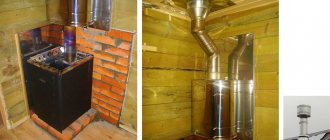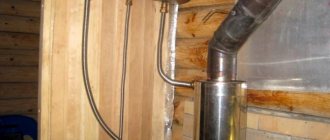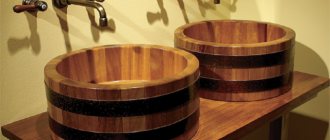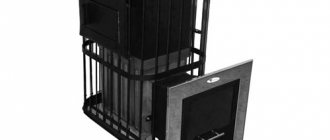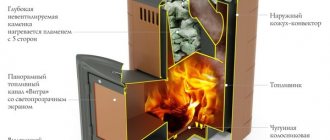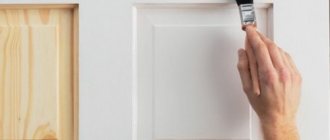Factors that have a negative effect on paint
According to experts, it can reach +600°C in the furnace due to fuel combustion. The steel becomes red hot. Periodic heating and cooling has a detrimental effect on strength indicators. A metal stove in a Russian bath is simultaneously exposed to high humidity and heat; the walls begin to rust inside and out. In a sauna the air is drier, but the air temperature is also higher.
Carbon monoxide can leak into the bathhouse through burnt walls; using an unprotected stove is dangerous to life.
Periodic heating and cooling has a detrimental effect on strength indicators.
Popular types of paints and varnishes for sauna stoves
Paint for a metal stove is quite in demand, so it is not difficult to find it on the modern market. The most popular fireproof paints are:
- Organosilicate products have long been known to a wide range of consumers, as they are used for various works. People who ask the question: “How to paint a stove?” first of all remember these paints. They can withstand temperatures up to 600 degrees.
- Some types of spray paint have increased heat resistance. They can withstand temperatures up to 650 degrees and can be applied in almost any environment, such as sub-zero temperatures or electrostatic fields. Heat-resistant aerosol paints are perfect for painting a boiler in a bathhouse.
- A sauna stove can be painted with electrically conductive paints, but it should be remembered that they have one significant drawback: the ability to reduce heat transfer.
If you want the decorative finish to maintain high aesthetic values for a long time, then painting the sauna stove should be done with products from well-known brands that have been on the market for a long time. Popular manufacturers value their reputation and sell products that have the characteristics stated on the packaging.
What tasks does paint perform?
A layer of paint for a metal sauna stove performs two functions at once: it increases the practicality of the sauna and improves the appearance of the dressing room and steam room. Heat-resistant coatings are resistant to thermal shock and have water-repellent properties.
By the way, welded structures with a tank for water and a firebox are sold in painted or unpainted form. The second option is painted before installation so that the steel does not have time to burn.
A layer of paint for a metal sauna stove performs two functions at once: it increases the practicality of the sauna and improves the appearance of the dressing room and steam room.
Why do you need to paint?
The main task of paint is to protect the surface from rust. No matter how high-quality the material from which the sauna stove was made, the consequences of negative influences may appear over time. The hot water tank is most at risk of rust, and due to the fact that it forms from the inside, it is quite difficult to avoid.
The second reason why a sauna stove needs to be painted is the aesthetic component. An object made entirely of metal is difficult to fit harmoniously into the overall picture of the room. Some finished products are sold already painted, otherwise you will need to do it yourself.
Do I need to paint or is there an alternative?
It is recommended to paint the metal before laying the heat-resistant brick screen and cover the inside of the tank. Instead of painting, bluing is used (details below) or other methods are used:
- Eco-friendly surface treatment with silver is quite effective;
- A budget option is red lead, used in metallurgy;
- A heat-resistant mixture of lime and cement provides good protection against oxidation.
It is recommended to paint the metal before laying the heat-resistant brick screen and cover the inside of the tank.
Types of bath paints
We have already said more than once that, with the exception of the steam room in the bathhouse, all other rooms are quite comparable to similar rooms in a residential building. Therefore, everything that is applicable in a residential building can also be used in a bathhouse.
Recreation room with wood varnish
IMPORTANT! Do not use only exterior paint compounds on interiors and vice versa.
The chemistry of paints is a complex thing. Nowadays, manufacturers are fighting to ensure that their products are better, which means they last longer, do not lose color, and are ready for various loads
Therefore, hybrids appear - for example, the addition of polyurethane makes the composition more durable and wear-resistant, which is important for the same sex
The main directions still exist, but their boundaries are significantly blurred by “hybrids”.
INTERESTING! Paints based on organic solvents are gradually becoming obsolete. But this is not just a tribute to fashion; they are outdated due to their toxicity to humans and the environment.
Alkyd enamels and their subtypes, nitro enamels, as well as oil paints - all this can be called “last century”. However, they are still produced by the paint industry and are in demand, but the main reason to purchase them is budget constraints.
Because with sufficient financial freedom, water-based paints are purchased - they are the most environmentally friendly, have a low odor that is not comparable to previous dyes, they are convenient to use and the result is decent.
However, today you can find the following types of water-based paints:
- acrylic;
- mineral (with the addition of cement or slaked lime);
- silicate (based on liquid glass);
- silicone.
Here we will go over the most optimal dyes for baths. Mineral ones, for example, last too long and are therefore doomed to lose demand.
Acrylic
It is successfully used to create coatings both inside and outside of various buildings. As a paint for baths and saunas, it can be used to cover any surface, including floors. Only in this case you need a special, wear-resistant variety, because walking on the floor erases the paint.
BY THE WAY! An important advantage of acrylic paints is their fire safety. This is compared to the “outdated” ones, which are completely flammable.
Acrylic bath paint can be successfully used for painting both wood and concrete surfaces. However, all this is stated on the labels. There are varieties suitable for painting walls and ceilings, there are special types for floors, and there are facade paints. In general, acrylic is applicable everywhere.
Acrylic varnish for baths, manufacturer “Yaroslavl paints”
Silicate
Silicon based dyes
They are used mainly outside, for facade work on brick or concrete. This creates a coating that will last 20 years - good news, right?
But brick baths are less common than wooden or wood-clad ones, so we’ll be brief here. Of course, it is suitable if it matches the type of surface.
Silicone
An expensive option, but suitable for finishing the same shower. Silicone dyes “breathe”; in addition, they are elastic, therefore the wood underneath will also “breathe”, and the elasticity will not allow the coating to suffer when the volume of the wood changes.
Silicone, for Elcon lining
Both silicone and acrylic dyes have a lot of advantages. They are durable, heat-resistant, fireproof, environmentally friendly and so on. However, they are not cheap yet. Nevertheless, we recommend them. (Latex ones are no less good - this is a type of acrylic with the addition of latex).
Latex paint Dali
Silicone enamel
Paint for an iron stove in a bathhouse
First of all, it is a durable coating that is least afraid of temperatures. That is, the pigments may turn out to be unstable and change color, say, at 150 degrees, but the coating will not lose its shape or change at all.
Actually, when we mentioned silicate paints above, this was silicone paint for facades. But now it is separated into a separate category, because there is a reason to use heat-resistant enamels in the bathhouse - this is painting a homemade metal stove.
Acrylate varnish
An alternative to covering wooden walls and ceilings in bath rooms, with the exception of the steam room, can be a water-based varnish that contains acrylates.
However, those who want to varnish wood floors of this type should take into account the fact that without special additives, scuba tanks are prone to abrasion. Of the additives that will increase its wear resistance, first of all it is worth mentioning polyurethane
Of the additives that will increase its wear resistance, polyurethane should be mentioned first.
Characteristics
Before painting a stove in a bathhouse, you should take into account a number of criteria by which paint and varnish materials are selected. There are several of them, each is important in its own way and affects the strength of coatings under the influence of “bath hazards”.
Before painting a stove in a bathhouse, you should take into account a number of criteria by which paint and varnish materials are selected.
Heat resistance
This indicator is indicated on the label in degrees. Manufacturers inform about the maximum heating at which the properties of the film formed after the coloring composition has dried are preserved.
Manufacturers inform about the maximum heating at which the properties of the film are preserved.
Corrosion protection
To prevent the metal from rusting, it is necessary to isolate the alloy from oxygen. Hydrogen increases the brittleness of metals, and nitrogen at high temperatures also has a negative effect on steel.
To prevent the metal from rusting, it is necessary to isolate the alloy from oxygen.
Water repellent properties
Choose paint coatings that repel moisture. This is necessary to prevent oxidation and cracking during the winter.
Choose paint coatings that repel moisture.
Safety
When heated, organic compounds release volatile hydrocarbons; such paints and varnishes can cause poisoning. The bath requires harmless, non-toxic paints and varnishes.
When purchasing paints and varnishes, the choice is made in favor of branded, time-tested products.
The bath requires harmless, non-toxic paints and varnishes.
How to paint a stove in a bathhouse
Regardless of the chosen material and paint composition, the metal surface must be cleaned to “white” metal, leaving no traces of rust oxidation or grease contamination. Under the influence of high temperature, all this can cause the paint to peel off, in which case it will not be possible to paint the chipped area. Most likely, you will have to sand the damaged area down to the metal base along the entire surface of the stove, only then will it be possible to carry out repairs and paint the surface with a fresh coat.
Heat-resistant enamel Cetra
One of the most popular versions of paints for coating high-temperature metal structures. Produced by Spectr. This is one of the most successful examples of the conversion of industrial material into consumer goods. The company produces Cetra in 26 shade options, operating temperatures in some cases reach 900°C.
But, before buying heat-resistant enamel for painting a metal stove, you need to pay attention to two important circumstances:
- The manufacturer does not directly state in the documents or on the packaging that Cetra can be used to paint a stove in a bathhouse. A more streamlined formulation is used that the paint is used for painting heating mains and gas pipelines, as well as when working with furnaces;
- Heat-resistant Cetra contains toxic toluene and metal carbonyls. Even after final drying, it is necessary to burn the metal furnace for at least two weeks in order to get rid of harmful components.
After painting, it is best to dry the oven outside the bathhouse for two days at 25°C or 12 hours at a temperature of at least 90°C. Only after this can heating be done in air and the stove returned to the bathhouse. The advantages of Cetra include a huge service life, as for paint, of at least 10 years.
Anti-corrosion zinc-filled enamel
One way to protect the metal furnace body is to use special additives, such as pulverized zinc. Low-viscosity compositions based on polyurethane or organosilicon polymers are usually used as a base. This type of painting can withstand, depending on the design, heating temperatures up to 300°C.
It is better not to paint a metal sauna stove made of heat-resistant stainless steel at all.
If you need to carry out local protection of the furnace from corrosion, then it is best to use varnish or paint in aerosol packaging, for example, as an option, the same “Cetra” or the safer “Hansa”.
Important! The zinc content in most brands of heat-resistant enamels with metal powder filler can reach 90%.
You shouldn’t get carried away with using zinc-containing paints; you can paint individual parts of the furnace body, fittings or valves. Places where the paintwork can come into contact with an open flame should be avoided; in this case, the organic part of the paint burns out, leaving metallic zinc, which gradually evaporates at high temperatures and can cause air poisoning in the bathhouse.
Ethyl silicate base and zinc powder
One of the most expensive types of heat-resistant protective coating is made on the basis of ethyl silicate, finely ground quartz powder and zinc filler. To paint a metal stove, you need to mix all three components and apply to the body with a brush or pneumatic spray.
As a result of a chemical reaction, a coating resembling ceramics is formed; such a stove can be placed in any bathhouse or steam room, without particularly worrying about environmental friendliness or durability. Many users claim that it is not possible to knock ethyl silicate off the surface of a metal stove even with a hammer.
Lead iron dyes
We are talking about iron oxide Fe2O3, a heat-resistant toner or, more correctly, a filler used to enhance the heat resistance of paint. The finest powder is calcined at high temperatures, which is why the ferrous lead acquires a red tint. Adding oxide to polyurethane or silicon silicate varnish makes it possible to paint the boiler, water tank, and any metal parts of the stove that are not in direct contact with the firebox.
Important! Unlike red lead, ferrous pigment is environmentally friendly; if necessary, it can be used to paint a water tank, even the walls inside the tank.
Silicone enamel
The main range of heat-resistant paints consists of organosilicon varnishes, such as KO85, KO815 with zinc, aluminum and ferrous fillers. To paint a stove in a bathhouse, you can buy ready-made enamels, ranging from KO8101, which can withstand heating on a metal surface up to 800°C, to the simpler KO811, KO813.
If funds allow, it is better to paint a metal stove with a silicon-containing coating, since organosilicon, unlike organic enamels, is not subject to thermal-oxidative destruction. Simply put, it does not burn and does not collapse under the influence of temperature, moisture or thermal shock.
Epoxy enamels
With all their advantages, such as high strength and durability, epoxy paints are not the best solution if you need to paint a “hot” single-shell sauna stove. To enhance the durability of epoxy paints, fillers based on titanium, zinc, aluminum and iron oxide are added to their composition. The heat resistance of epoxy is limited to a ceiling of 300 ° C, so it can be used maximum for a two-body stove installed in the wall between the dressing room and the steam room of the bath.
It makes sense to paint with epoxy powder only if you want to ensure a formal appearance of the stove; usually epoxy thermal enamels are used for apartment wood-burning boilers and fireplaces; they are not so popular for bathhouses.
A mixture of liquid glass and aluminum powder
A mixture of sodium silicate and aluminum, after adding a small amount of water, turns into a low-viscosity liquid that can be used to paint any surface free of scale. You can only paint it with a brush, but you need to apply it in a thin layer, otherwise the strength of the protective coating is sharply reduced.
The paint is absolutely harmless to bathhouse visitors
To improve heat transfer, aluminum powder is added to sodium silicate. The heat resistance of paint based on silicate glue is limited to 700°C. With homemade paint you can paint any parts of the stove in a bathhouse without any special restrictions. True, there is one peculiarity: sodium silicate does not like direct contact with fire; the paint begins to collapse and turn into a porous structure reminiscent of pumice.
Kinds
Heat-resistant paint for sauna stoves is produced in a large assortment. Paint and varnish mixtures are classified according to their basic components:
- Organosilicon coatings form a glass film that retains strength at +800°C, have good adhesion to metal, and are not afraid of water;
- Polyurethane is wear-resistant, can withstand heating up to +600°C, and is often used for boiler equipment. Minus - some compositions change color due to thermal exposure;
- Water-based ones with acrylic filler are more suitable for saunas or painting the stove on the side of the dressing room, where there is no high humidity.
According to user reviews, several heat-resistant coatings deserve attention:
- “Hammerite”, “ELCON” - enamels with corrosion inhibitors;
- “Kudo” enamels with silicon;
- “Hansa” in aerosol cans or cans is produced in about 16 shades;
- Gray or black “Tikkurila” with alkyd resin;
- "Bosni" is a universal composition for many types of surfaces.
For reference. For thin-walled fireboxes, it is recommended to choose coatings with a heat resistance rating of +800...850°C.
Water-based ones with acrylic filler are more suitable for saunas or painting the stove on the side of the dressing room, where there is no high humidity.
Color selection
It is traditionally believed that heat-resistant coating depends on the color and even shade of the paint. For example, if you want to get the maximum level of heat resistance, then it is better to choose dark colors, brown or black. Usually black bathhouses are made of metal stoves based on cast iron or silicon steel.
Article on the topic: How to make concrete pillars for grapes and a fence
On the other hand, red, brown, cream and even white colors are widely used for alloy and stainless steel stoves. Usually the decision on what color to paint the stove is made in accordance with the design of the steam room and the entire bathhouse.
Is it possible to coat equipment with enamel?
Among the large number of paints for a hot water tank in a bathhouse, it is better to choose special enamels marked “KO 8” from leading manufacturers. This means that silicone enamel can withstand high temperatures. Conventional enamels for metal quickly become painted due to temperature changes.
Silicone enamel can withstand high temperatures.
Coloring bath equipment
Elevated temperatures, high humidity, frequent heating and cooling cycles cause rusting not only of the sauna stove, but also of other metal structures located in the steam room. This primarily concerns the tank intended for hot water. It needs to be painted not only from the outside, but also from the inside, since the water in it will cause corrosion.
Painting the tank is carried out according to the same rules listed above. The only difference is that it needs to be coated with paint and varnish at the manufacturing stage. Once it is installed, such work will not be possible.
In addition to the tank, it would not be superfluous to paint the heat exchange system and the chimney pipe, which rusts quite quickly. It is better to paint boilers and other metal surfaces that the steam room is rich in at the same time. When answering the question of how to paint the tank and other metal surfaces of the bathhouse, the already mentioned paints and varnishes should be mentioned.
In addition to other advantages of painting stoves, tanks and other structures, it is also necessary to highlight the fact that cracks can appear on hot metal (especially cast iron) when it comes into contact with water. Thus, the painted stove can be safely used in a room with high humidity.
Coating instructions
When painting stoves yourself, it is important to follow the sequence of operations and adhere to the technology, then the bathhouse will be protected.
When painting stoves yourself, it is important to follow the sequence of operations and adhere to the technology.
Tools and materials
In addition to paintwork materials and brushes, you will need sandpaper or a metal brush to remove rust, and a solvent to degrease steel. It is necessary to cover the floor and wall so that there are no smudges.
In addition to paintwork materials and brushes, you will need sandpaper or a metal brush to remove rust, and a solvent to degrease steel.
Surface preparation
The metal is pre-cleaned to a metallic shine. After removing dust, wipe the surface with a solvent.
Stainless steel fittings and adapters are coated with grease to protect them from staining.
The metal is pre-cleaned to a metallic shine.
Work algorithm
Mix the paint before use, start painting from hard-to-reach places, then cover the remaining areas. Coatings are applied in one layer, unless otherwise specified by the manufacturer.
The paint is mixed before use.
How long does it take for the coating to dry and after what time can it be heated?
It is better to wait 5 days after painting, only then start lighting the stove. Paint for a metal stove in a bathhouse dries on average from 72 to 96 hours, depending on the plasticizer.
Some coatings dry only when heated; the stove is lit, but not allowed to become very hot. For safety, open the window and door.
It is better to wait 5 days after painting, only then start lighting the stove.
How to coat
In order for enamel or paint to stick well and for a long time on the metal surface of the stove, it is not enough to choose the appropriate composition. It is necessary to strictly adhere to the technology when applying it. All the necessary information is on the packaging, but the principle is the same for any product.
Surface cleaning
Dust, dirt, rust, old coating and any other layers will not allow the paint to adhere well to the surface and adhere to it. They need to be removed.
- First, they use a metal brush to remove obvious contaminants and loose rust.
- Then the surface is brought to a shine with a drill with abrasive attachments or sandpaper.
Cleaning metal from rust Source yandex.net
For reference! If the instructions allow, instead of a mechanical cleaning method, you can use a chemical one by applying a rust converter to the surface.
- The next step is to remove dust using a soft broom or vacuum cleaner and damp wiping.
- The dried metal is degreased using a solvent recommended by the manufacturer. If there is no such recommendation, you can use white spirit or solvent P 646.
Solvent 646 does not cause metal corrosion Source artikaluga.ru
Burnishing an iron stove
Blueing is the etching of metal with phosphoric acid, which creates a protective layer of phosphates on the steel. A similar technology is applicable in baths. The cleaned, degreased metal surface is treated with a solution of phosphoric acid. Add 150 ml of acid and 4 g of butyl alcohol per liter of water. After the solution has dried, the metal is washed with laundry soap. Then the surface is heated to 150 C, and a 10% solution of caustic soda is applied to them using a spray gun.
Blueing is the etching of metal with phosphoric acid, which creates a protective layer of phosphates on the steel.
If desired, the metal stove and tank can be made into decorative parts of the bathhouse interior. For painting, it is better to choose heat-resistant enamels, which are durable and decorative. There will be no rust with this coating.
Painting a stone stove
Some bathhouse owners prefer to use brick stoves. Their installation is more expensive, but they look acceptable in a Russian bathhouse. It is easier to choose paints for a brick stove. They are often painted with chalk or lime.
Before we talk about whether paints are needed for a brick oven or whether it is better to use proven old-fashioned methods, that is, ordinary whitewashing, it is necessary to describe the preparatory work. They look like this:
- the first step is to eliminate all existing defects by plastering the surface;
- the seams need to be covered with clay solution;
- Before painting brick stoves and fireplaces, you should wait a certain time for the cement and clay mortar to dry.
Not only traditional methods (chalk and lime) are perfect for brick stoves, but also heat-resistant paint used for painting iron stoves. Everything has already been said above about the third staining method, but the first two should be discussed in more detail.
Chalk coloring
If you decide to use chalk as a coloring material, then you need to proceed as follows:
- Two kilograms of chalk are poured into any container and filled with warm water. There shouldn't be much of it. The main thing is that there is enough to hide the chalk. The mixture should be allowed to brew for an hour.
- At the same time, in another container you need to mix glue with warm water in a ratio of 1:25. It is necessary to use animal glue, such as bone glue.
- Both solutions must be combined and brought to a homogeneous consistency. To check the quality, you can drop the solution onto the glass, which you want to put in a vertical position. A high-quality mixture will slide down the glass by a maximum of 2–3 centimeters.
- To achieve a good result, you need to apply several layers of the solution. Each new layer is applied after the previous one has dried.
If you want to achieve an ideal result, you need to take the blue and add it to the solution at the rate of 1 tablespoon per bucket. It will eliminate the possibility of yellowing.
Choosing paint for the stove
The operating temperature for standard metal paint does not exceed 40-50 ℃, so you cannot paint surfaces that are too hot - it will bubble up, lose its original color and may begin to smoke and smell unpleasant. Therefore, in this case, you need to use only special heat-resistant paint for stoves.
Which of the proposed paint options to choose will depend on the area of its application. Thus, a metal sauna stove can heat up to 600-800 ℃ or more - at the epicenter of combustion the temperature is even higher. But its outer walls may not heat up so much - it all depends on the design. Therefore, you need to know how to properly install a stove in a bathhouse. If we are talking about a brick oven, then its surface does not warm up above 200 ℃.
Recommendations from experts
The main task of the paint is to create an attractive appearance for the brick and protect the surface. No matter how high-quality the product is, over time cracks appear on the painted layers. This is a common decomposition reaction of the substance, but the period can be increased if the painting is carried out correctly and you take into account the advice of experts:
The correct choice of what paint to paint the brick stove in the house is the main point that will eliminate minor nuances in the future. You should not buy cheap products. Such savings will require double costs in the future.
One of the ways to dilute paint in a separate containerSource sdelalremont.ru
If the paint is too thick, then it must be diluted only with a solvent. The density of the fresh substance should be kefir mass. This composition will not require dilution and will not spread during application. To increase the strength of the mixture at home, it is recommended to add 40-50 g of table salt per jar.
It is important to first dilute it in warm liquid. If there are old layers of paint or lime on the stove, they should be removed. The limescale composition can be easily removed with water, and soft sandpaper can be used to remove paint. When purchasing brushes, you should not save money on them.
It is better to buy a wide tool with natural bristles. When purchasing them, you should check them and touch the fibers. They should be soft but elastic. If you decide to use a roller, it should be made of foam rubber or short-pile fur. Many paint manufacturers write on the packaging that it is enough to apply one coat of paint, but experts advise working in three stages. First, a “rough” layer is applied, then the main one, and only after that the finishing layer.
Applying the first layerSource gidpokraske.ru
- Do not mix several types of enamels. It is prohibited to apply paint and varnish without first preparing the surface.
- Before buying paint, it is better to calculate the oven area to find out how much dye to purchase. This will save money.
After completing the work, it is better to close the room for a day and, if possible, not enter there. After 24 hours, you can already go into the room to check the condition of the stove and open the windows for ventilation.
When choosing what to coat a brick oven with and with what tools, pay attention to all types of paints in cans or bottles, except those in aerosol cans. The composition sprayed with their help lies unevenly on the surface of the oven, and additional layers will lead to differences in shade.
Result of painting after applying the third layerSource centr-terrasnoi-doski.ru
What is used today?
Times have changed and no one cooks whitewash today. Modern owners of Russian stoves and fireplaces prefer other means. Let's look at each option in more detail.
Natural drying oil
Natural drying oil is used as stove paint - this coating does not change the color of building materials, but slightly changes the shade to a darker side.
Organosilicon paint
Along with drying oil, silicone paints are widely used for brick stoves. These compositions have many advantages:
- high adhesion to any materials;
- coating strength;
- resistance to moisture;
- high durability;
- heat resistance (withstands more than 200 cycles of temperature changes).
Alkyd based varnish
PF-283 varnish is also often used for painting fireplaces. It is a mixture that includes alkyd resins, modified vegetable oils, fatty acids and other additives. The varnish is mixed with turpentines in equal proportions. This increases the durability of the coating. After drying, a glossy transparent and very durable layer is formed on the surface.
Heat resistant paint
The most popular option is the use of heat-resistant paints for stoves and fireplaces. The material has a huge number of advantages:
- large range of colors;
- this is a heat-resistant paint - it can withstand temperatures up to 600 degrees;
- the surface of brick stoves and fireplaces is reliably protected from oxidation;
- the material has increased strength and wear resistance characteristics;
- performance qualities are maintained for more than 10 years.
Heat-resistant paint also has disadvantages, among which we especially need to highlight its aggressive composition, unpleasant odors, and long drying time.
Due to the presence of toxic substances in the composition, you should be careful when working with thermal paint
In the video: DIY heat-resistant paint.

